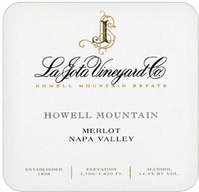|
|
 |

Mt. Brave, Napa Valley-Mt. Veeder Merlot 2013 ($75) and La Jota Vineyard Co. Napa Valley-Howell Mountain Merlot 2013 ($85): Recently, I praised the 2013 mountain-grown Napa Valley Cabernets of Lokoya. Now it’s Merlot’s turn: Same vintage, same mountain viticulture, same winemaker (Chris Carpenter), same corporate ownership (Jackson Family Estates), but a different grape and, for the quality, admirably affordable prices.
Mountain viticulture encompasses several factors that positively influence the quality of Merlot grapes. The cooler temperatures at high altitudes foster a slower, more even ripening of the grapes; sites above the fog line enjoy longer sunshine which enhances ripening; and thin, stony mountain soils result in small crop levels and smaller, more concentrated grape berries. The difficulty and challenge of mountain viticulture is itself another influence, because it demands dedication from the growers and winemakers who work the vines. In 2013, all these factors converged with an ideal growing season that saw temperatures hover in the 85° to 95° range, without heat spikes, and dry conditions throughout.
These two 2013 Merlots hail from opposite sides of Napa Valley: Mt. Brave Merlot, from Mt. Veeder in western Napa Valley and La Jota Merlot, from Howell Mountain in the east. The two wines are equally impressive, but in fact quite different.
The Mt. Brave Merlot is a wondrously rich and harmonious wine that is as smooth as it is big. As soon as the wine enters your mouth, its generosity  becomes evident: the soft attack evolves into a full mid-palate that’s plump with ripe fruit, and segues into a characterful finish of concentrated fruit and age-worthy tannin. It’s a beauty of a wine but it’s in no way simple or vacuous. Aromas and flavors of dark cherry, chocolate, sweet spice and floral notes float in a frame of velvety tannin, interweaving with that tannin on the finish. This wine has a long life ahead of it, despite being delicious now. becomes evident: the soft attack evolves into a full mid-palate that’s plump with ripe fruit, and segues into a characterful finish of concentrated fruit and age-worthy tannin. It’s a beauty of a wine but it’s in no way simple or vacuous. Aromas and flavors of dark cherry, chocolate, sweet spice and floral notes float in a frame of velvety tannin, interweaving with that tannin on the finish. This wine has a long life ahead of it, despite being delicious now.
The La Jota Merlot is more linear and more refined. It’s a trimmer, less opulent Merlot than the Mt. Brave, but within its leaner frame it hits the classic Merlot descriptors of smoothness, softness and richness. Holding the wine in your mouth and swishing it around, you can feel the silkiness of texture within the wine’s firm tannin,  and sense the impeccable balance of acid and tannin to fruit and alcohol. The fruit itself is outstanding, seeming to embody a perfect acid to sweet-ripeness ratio. Aromas and flavors are pure and precise, suggesting blackberry and plum mingled with mocha and a cool minerality. It is thoroughly enjoyable now for those who enjoy more subtle wines, and its balance argues for long potential. and sense the impeccable balance of acid and tannin to fruit and alcohol. The fruit itself is outstanding, seeming to embody a perfect acid to sweet-ripeness ratio. Aromas and flavors are pure and precise, suggesting blackberry and plum mingled with mocha and a cool minerality. It is thoroughly enjoyable now for those who enjoy more subtle wines, and its balance argues for long potential.
In a sound bite, Mt. Brave Merlot embodies glorious ripe-fruit opulence compared to a subtle and gentle Euro-sensitivity in the La Jota Merlot.
The Mt. Brave Merlot from Mt. Veeder contains 5 percent Malbec. (Mt. Brave also makes an impressive, beefy 100-percent Malbec wine.) The La Jota Howell Mountain Merlot is 91.5 percent Merlot, with 5 percent Cabernet Sauvignon and 4.5 percent Petit Verdot. Winemaking is similar for both wines, involving hand harvesting; native yeast fermentation; 20 days of maceration on the grape skins; and 19 months of aging in French oak barrels, 80 percent of them new for the La Jota and 85 percent of them new for the Mt. Brave.
Both wines exemplify how world-class impressive California Merlot can be under the best circumstances.
Mt. Brave Merlot, 92 Points
La Jota Merlot, 93 Points
|
 |
|